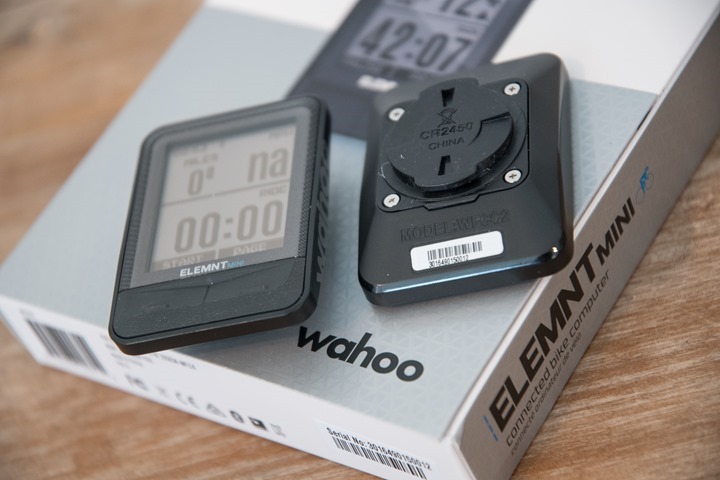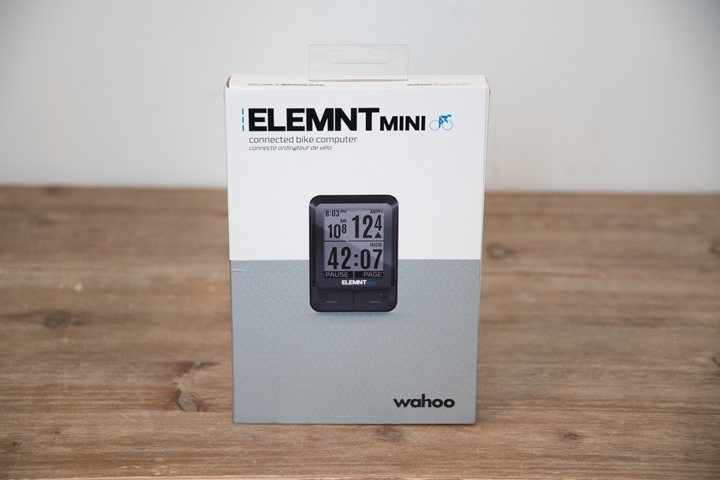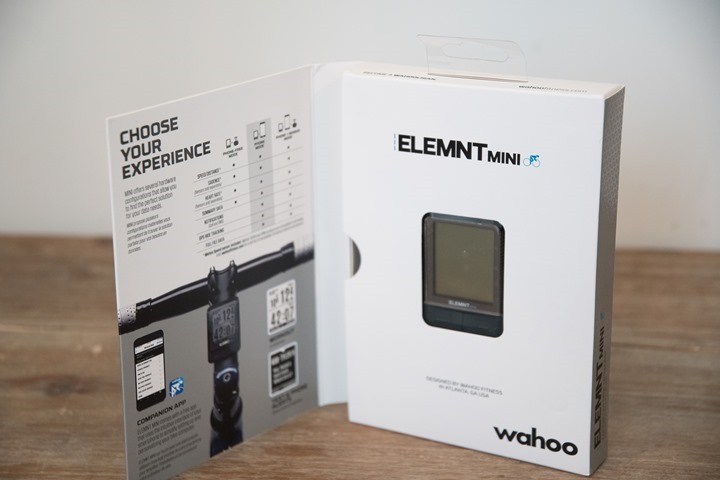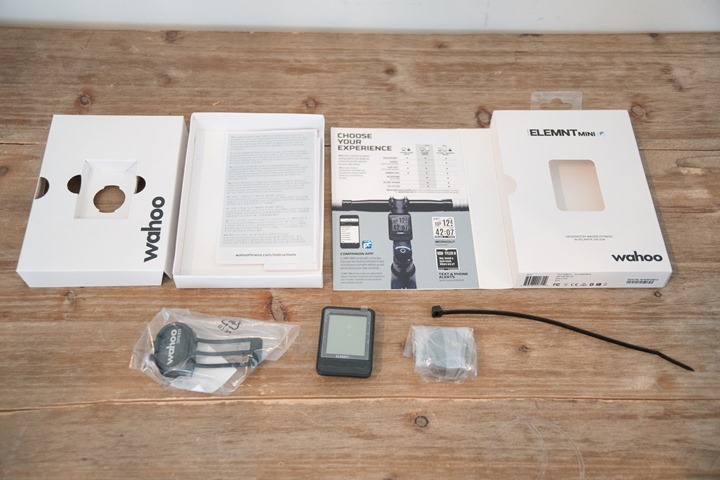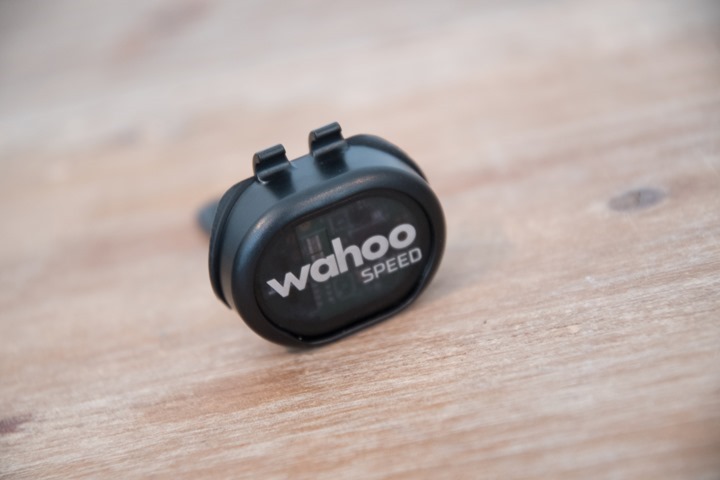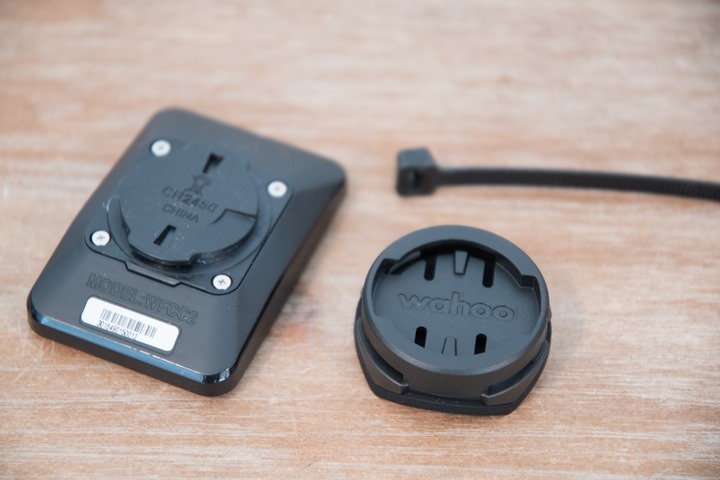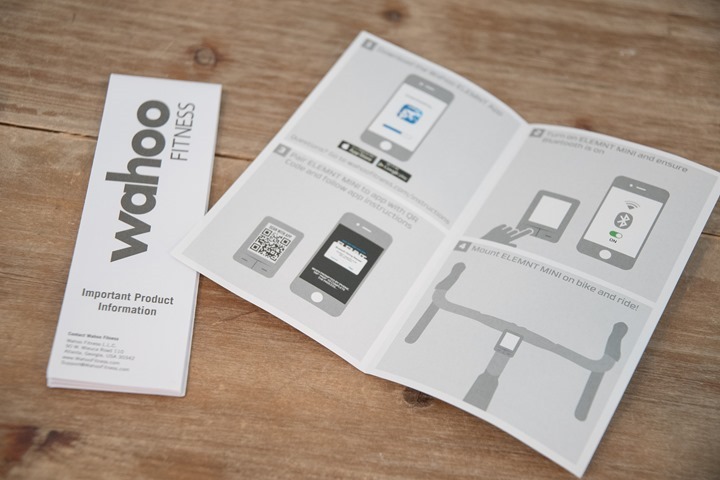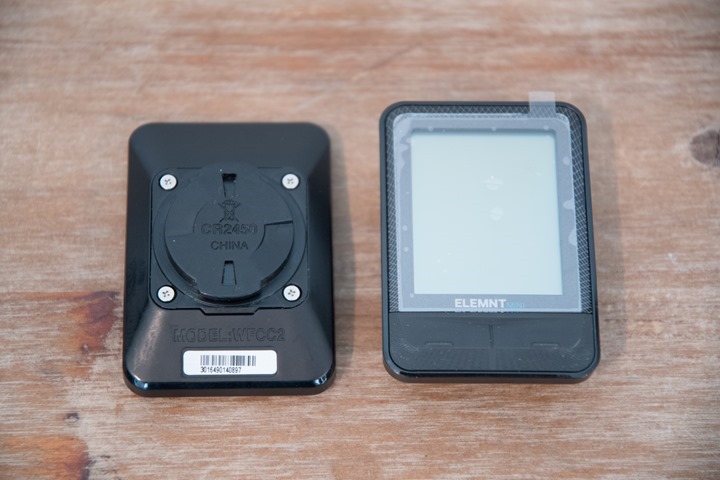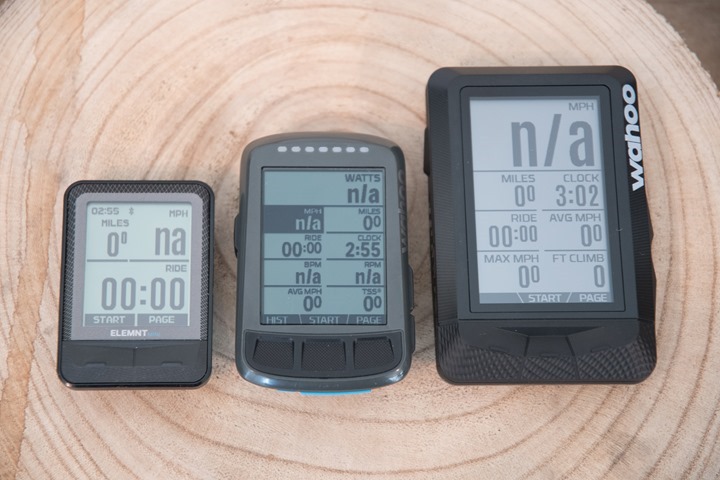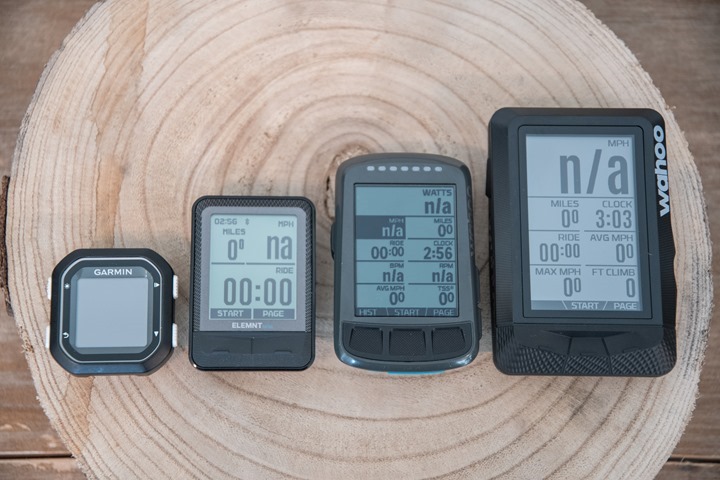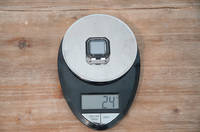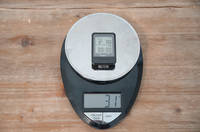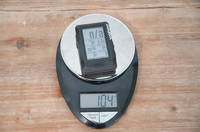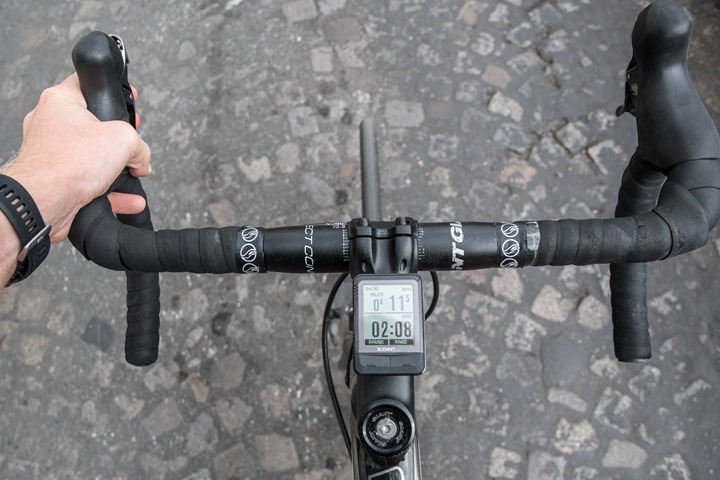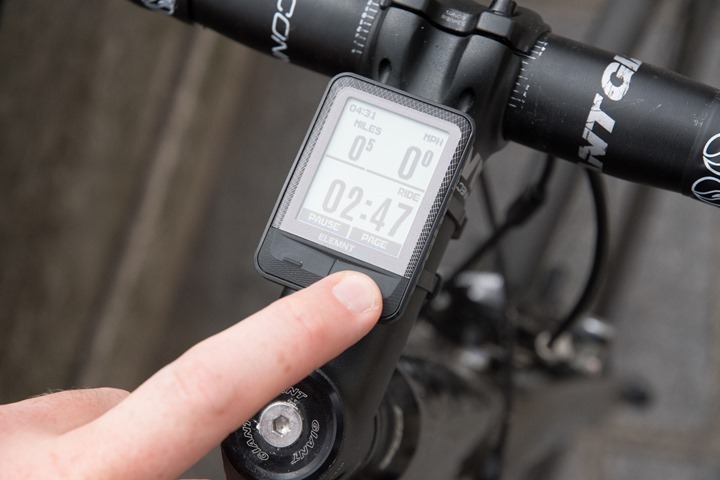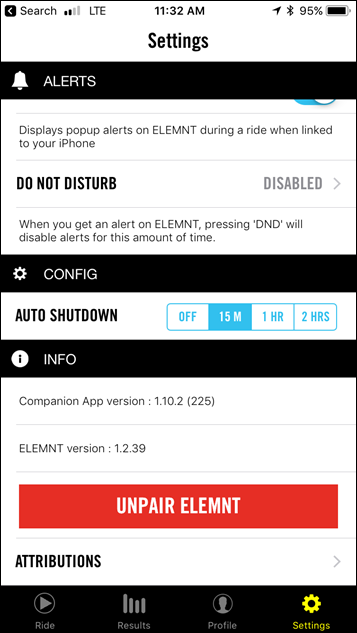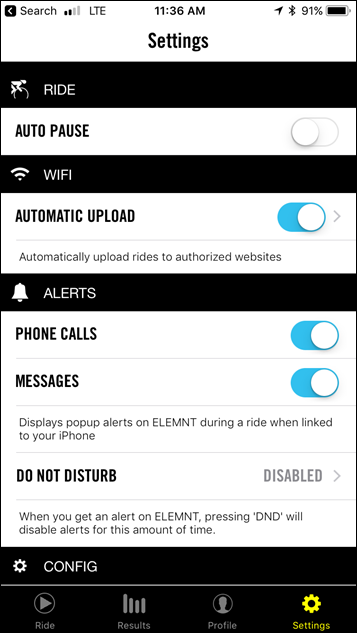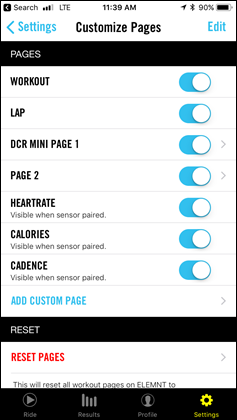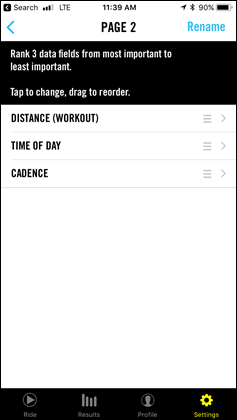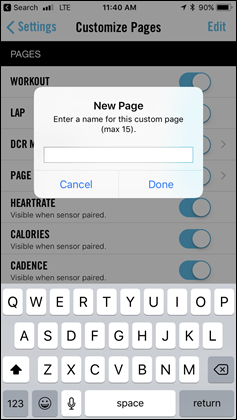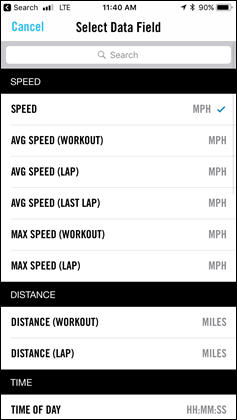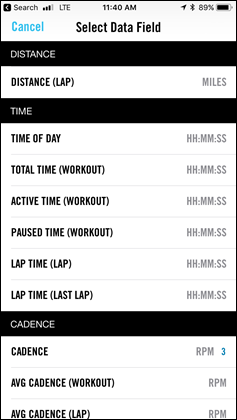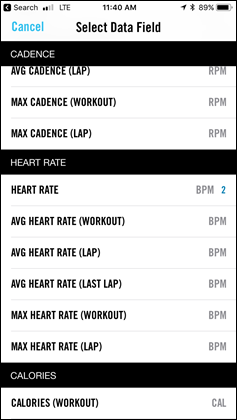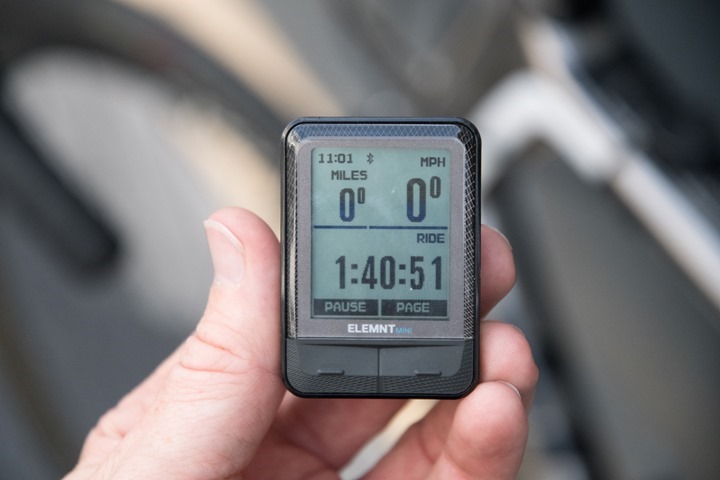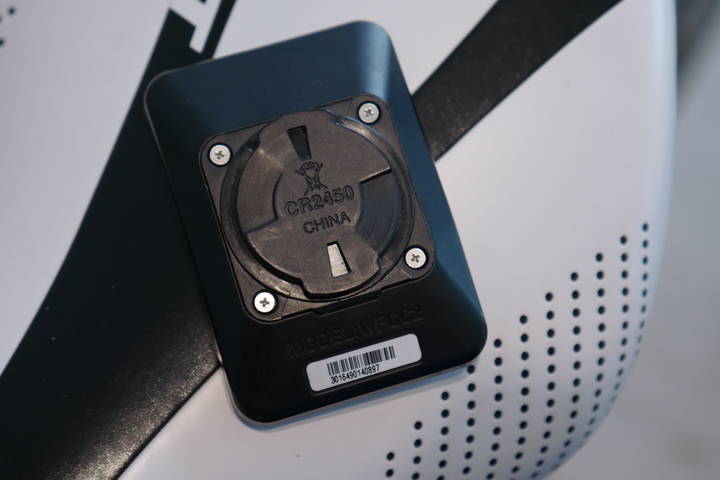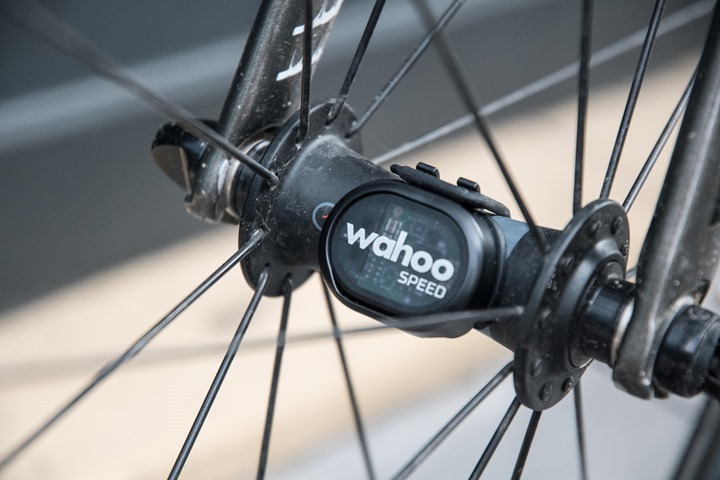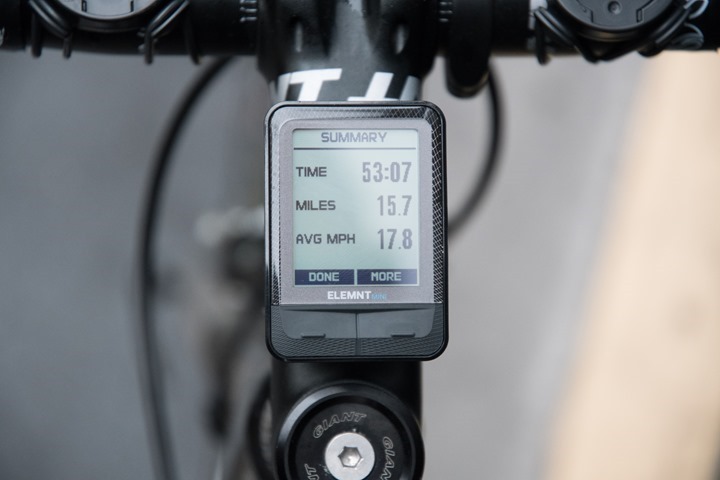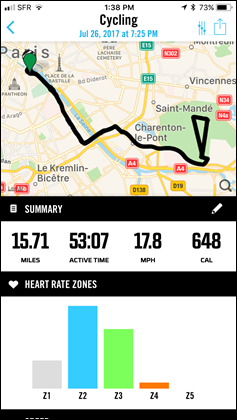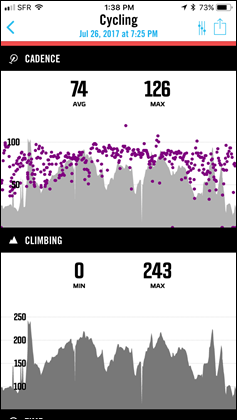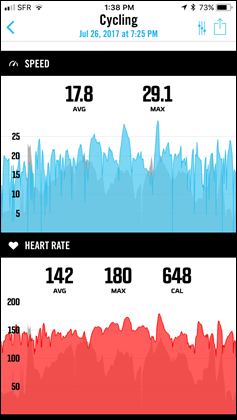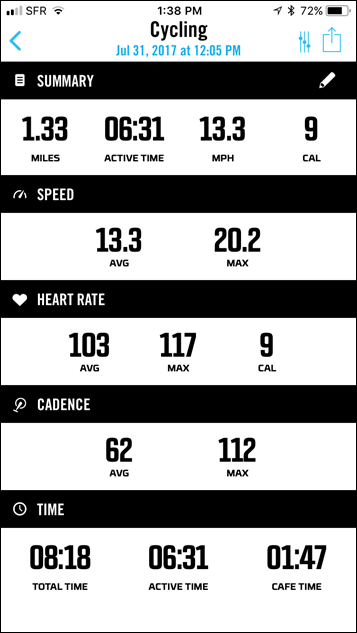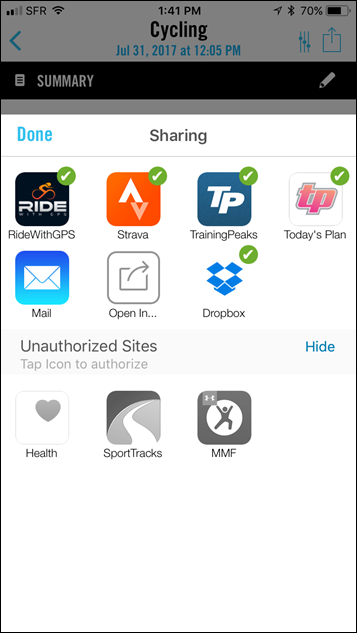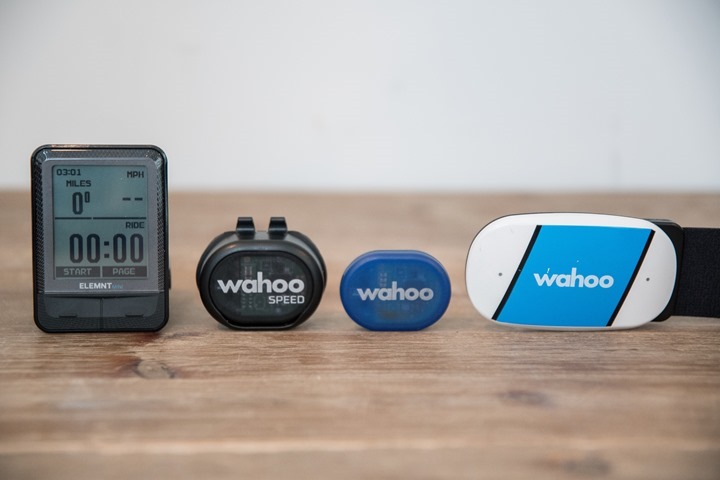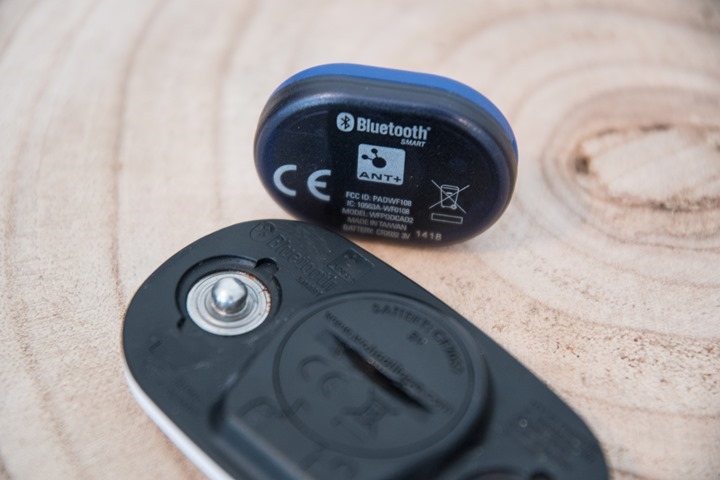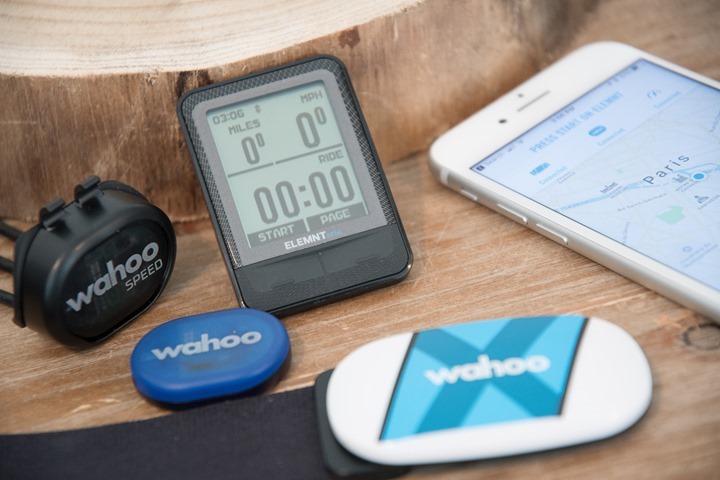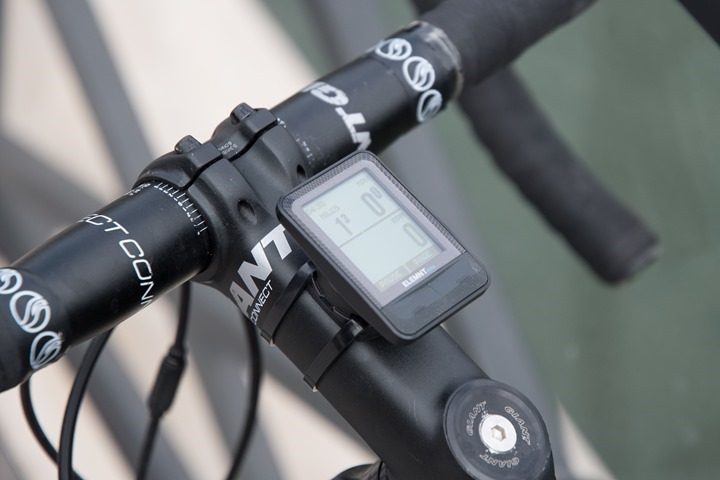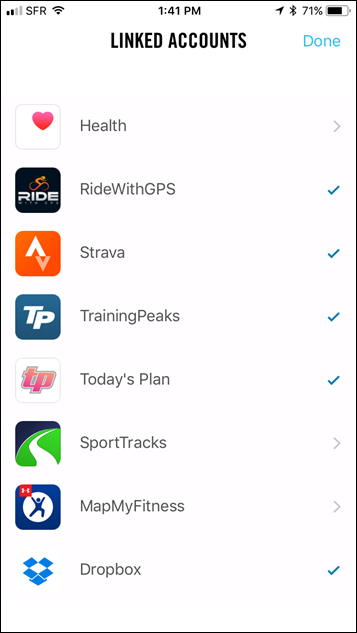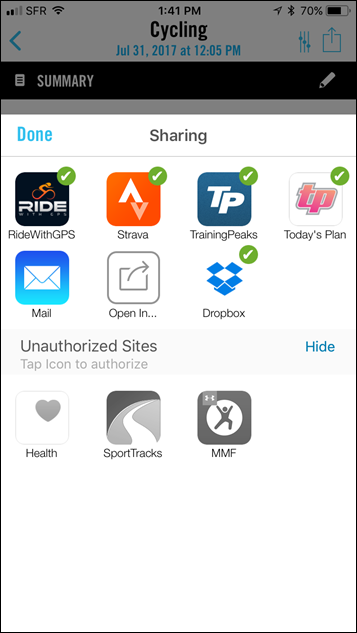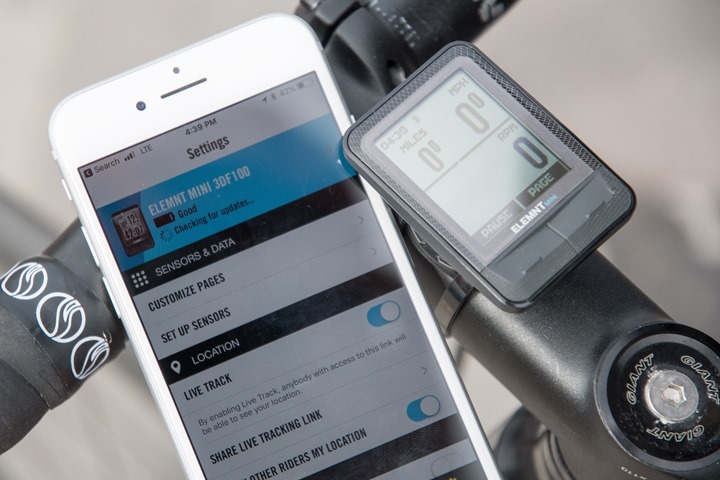Today Wahoo announced their newest product in the ELEMNT bike computer lineup, the MINI. This $99 (including a speed sensor) unit is aimed more at the bike commuter and/or recreational cyclist than the hardcore one. It’s also a tip of the hat back to the days of the Wahoo RFLKT and RFLKT+, but without most of the baggage of those devices.
As I’ll explain in this post though, it’s important to understand this isn’t just a smaller form factor BOLT or ELEMNT. Rather, it’s really a different product with a different target audience. It does indeed have some very specific restrictions which may not sit well with a number of readers here (and on the flipside, may not mean anything to others).
This is actually a product that’s been in the hopper for quite some time (a really long time). Wahoo sent over a few MINI’s to test out, but as usual, I’ll send them back to them once I’m done with this review here. Just the way I roll. If you find this review useful – feel free to use the links at the end of the post to increase your awesomeness level.
Wanna video look at things instead? Here’s everything you need to know in one tidy little package (un-boxing in first portion, then understanding features/limitations, then close-up hands-on is around the 11:50 marker):
With that, let’s get this party started.
Unboxing:
First up, we’ve gotta crack this thing open and get the unit out.
If you dump everything on the table, here’s what you’ve got:
So first in line we’ve got the Wahoo dual ANT+/Bluetooth Smart speed sensor (actually just branded Wahoo SPEED):
Then we’ve got the mount for the MINI, which uses zipties, allowing you to place it on your handlebars or wherever else you want to ziptie things. I keep hoping Wahoo will go the way of Garmin and Polar with heavy duty rubber bands instead…a guy can dream, right?
Then we’ve got some paper stuff:
And finally, the MINI itself (yes, I had two units):
What do you not notice in here? A charging cable. That’s because the MINI uses a coin cell battery, so no charging necessary (or possible) here.
To briefly compare sizes, here’s how it compares against Wahoo’s other units – the BOLT and full-sized ELEMNT:
And then here’s how it compares against the Garmin Edge 25, which is kinda in the same market (albeit more expensive and with GPS too):
Finally, a quick gallery of weight comparisons:
As you can see, it’s pretty darn light – in large part because it lacks things like a heavy battery.
The Basics:
The first thing to understand about the MINI is that it’s not the BOLT or ELEMNT. Sure, it’s part of the ELEMNT line, but there’s a considerable number of differences here that really make it like an iPod compared to a full blown MacBook. For example, the MINI doesn’t have GPS within it. Rather, it leverages your phone’s GPS. Same goes for the altimeter, which also leverages your phone’s altimeter (most phones have altimeters these days) for elevation data, and falls back on GPS elevation if your phone lacks that.
Form-factor wise, first up is that the MINI only has two buttons on front, down along the bottom:
These two buttons wake it up from its normal sleeping state, as well as allow you to press start/stop, trigger a lap, and change the page….and that’s about it. The unit will automatically go to sleep per the settings in the companion app, which by default is 15 minutes after the ride ends. That settings app is where you can configure both basic options like the auto-shutdown, as well as aspects like smartphone notifications and auto-pause:
The same goes for live tracking too. And this is the area where the MINI overlaps with the BOLT and ELEMNT. For example, you can see phone calls and text messages, as well as enable DND (Do Not Disturb) mid-ride. And the Live Tracking? It’s the same as the just-announced variant for the BOLT/ELEMNT.
As noted above, you can customize data pages, and a crapton of them at that. Most units this small only have 2-4 data pages, with usually 1-2 data fields each. The MINI though seems to allow near endless data-pages (or at least, I got tired of adding more and more pages). Each page allows up to three metrics on it. You can also change the order of these pages (or temporarily disable certain ones).
Here’s all the data fields you can use/add to your pages:
The only downside is that while the screen would perfectly fit four metrics per page, it’s sorta randomly limited to three metrics. The bottom metric becomes the ‘bigger’ metric, but in reality the text is no bigger, except if you’re talking something like time (such as 1:40:51 – 1hr 40min 51sec), because then it stretches across the entire bottom:
Note that it’ll always show the time in tiny numbers up top on the upper left edge, which I like. You’ll also see the Bluetooth Status up there too.
Now it’s important to note that the MINI has two basic modes:
Phone-free mode: When you’ve broken your phone, it’ll use the speed sensor for speed/distance
Phone-mode: When you have your phone, it’ll use that for GPS (and thus speed/distance)
Both modes though allow the pairing of sensors (for which I need an entire section below to attempt to explain), including heart rate, speed, and cadence. Within the phone-free mode though, you’re not going to get as much detail after the fact. Mostly just a simple summary of what you did, which shows up on the device itself, as well as on the companion app.
Whereas within phone-mode, you’re going to get GPS data, and as such also mapping data. Further, you’re going to get full sensor data recorded as well (including heart rate, speed, and cadence). That also gives you a brief summary on the device, but then afterwards far more detail in the app.
The idea being here that if you’re doing bike commuting for example, you’d have your phone with you and that the MINI could just leverage your phone for the heavy-lifting (which is the GPS side of things). That in turn saves battery. The two biggest killers of battery life on most devices are GPS and backlight. Given the MINI has neither, it’s able to last a heck of a long time on a single coin cell battery (CR2450). Wahoo claims 250hrs on a single battery:
Speaking of sensors, now’s a good time to remind you that the MINI does come with the Wahoo SPEED sensor included. This is a magnet-less speed sensor that you attach to your front or back wheel. If you attach to your front wheel though, it likely won’t track speed on a trainer, since that’s not moving anywhere. It just simply wraps around using the rubber band. I’ve been using one for a year or two since they first came out and they work great.
So what about riding with it? Well, it’s quick and reactive. Since it’s using the included Wahoo Speed sensor for distance and speed, the responsiveness is nice and swift. And pressing pages is also responsive and there’s virtually no lag in doing so. You can long-hold the ‘Page’ button to trigger a lap, which then updates lap-related metrics like average lap speed or lap heart rate. And, of course, you can pause at any time too, useful for those mid-ride ice cream stops.
Upon completion, you’ll pause and then press end to complete the ride. The MINI gives you a bit of a lame summary screen, with only two pages of metrics, not a ton of detail (the second page upon pressing more merely shows you average HR, average cadence, and calories):
Still, the companion app then fills in those gaps and shows more detail (for a fully connected ride). Here’s what that looks like for a phone-connected ride with all the sensors you can imagine (Wahoo SPEED, Wahoo TICKR heart rate strap, Wahoo RPM cadence sensor):
At which point it’ll sync to any of the 3rd party apps/platforms that you’ve configured (more on that down below though). With your ride on Strava, you’re good to go off and eat more dessert.
And for completeness, here’s what a phone-free ride looks like. Note on this ride I had the exact same sensors, the only difference is that I left my phone behind. As you can see, you get basically nothing other than max/avg/total values. You can share it to other sites though:
Now before we dive into the Strava and other platforms piece, we need to take a brief detour about those sensors.
(For lack of anywhere else to note it, the MINI does NOT do any navigation at all.)
A Story About Sensors:
So then. Things are about to get a bit awkward here. Let me just lay it straight on the table:
The MINI only works with Wahoo Fitness sensors.
And actually, to be more precise: The MINI only works with Wahoo Fitness dual-band sensors (meaning, dual ANT+/Bluetooth Smart).
That means in the unlikely event you’re still rockin’ an original BlueSC or BlueHR from about 5 years ago, that you’re out of luck, as those are Bluetooth Smart only. However, if you’ve bought any of their sensors in the last 2-4 years, there’s about a 99% chance it’s dual ANT+ & Bluetooth Smart. You can always double-check by looking for the two logos on the back of the sensor:
Now, as Wahoo themselves can attest to, I’m more than displeased about this requirement. I explained to them that this was effectively taking us back to the mid-2000’s in the days of having a cheap bike shop bike computer that only worked with their branded sensors. It’s undoing all the work that having standards like ANT+ & Bluetooth Smart for fitness have been working for. Even more so since Wahoo’s really been at the forefront of pushing those standards. After all, their very first product was a device to get open-standard ANT+ data into the closed iPhone platform (Pro Tip: That post is a blast from the past).
But let’s dig a bit deeper into why they’re doing this. In lengthy back and forth’s about this with them, they explained the reasoning this requirement is there. Note, this might get a bit geeky.
Remember above when I said the MINI has two basic modes? Phone free and phone-connected. What Wahoo is doing here is to actually split the data channels from sensors. One channel (ANT+) goes to the MINI, while the second channel (Bluetooth Smart) goes to the phone.
The thinking there is that it reduces issues with sensor data when the MINI can’t connect to your phone. This can happen due to you eating too many tacos for lunch, or just general electronic interference from nearby stuff. Since most people put their phone in their back pocket, it’s a trickier spot to keep constant 1-second update-rate data connectivity for hours on end without a blip. Wahoo themselves know this better than almost anyone else in the industry, since their previous product – the Wahoo RFLKT – depended on this exact same architecture.
With the RFLKT, it required a constant and always-up channel. When that didn’t happen, things got ugly quick and data was lost. Thus by making the MINI less dependent on the phone, they solved that issue. But it didn’t solve the issue of how to get sensor data to both the phone and the MINI. That’s because the MINI doesn’t actually talk to Bluetooth Smart sensors. Rather, it only talks to ANT+ sensors, and the phone only talks to Bluetooth Smart sensors.
Meaning that the files that you get uploaded to Strava, are actually from the sensor/etc data taken from the phone via Bluetooth Smart, not from the MINI. The data collected during a phone-paired ride on the MINI actually goes nowhere. Like a fart in the wind. It’s redundantly useless, except for showing you that data during the ride on the MINI itself.
And even more to the point, remember in a phone-free ride, you only get summary data upon completion of the ride, no second by second (or similar data).
So why not simply do as they do on the BOLT and ELEMNT and have the MINI connect to both sensor types and then update the phone accordingly via Bluetooth Smart (or even after the fact)? Well, their answer roughly consolidates to they ‘thought it would be too complex for the target market for this computer’.
Their thinking was that the main target audience for this unit wasn’t necessarily people who may already have a BOLT or Garmin, but rather people interested in getting a bike computer for the first time. Said differently (in my words): People walking into an Apple Store and deciding to get a $99 bike computer with no research.
That market they noted wouldn’t likely have existing sensors, and would need something to solve the no-phone use case.
And perhaps not having existing sensors is true (though, I even challenge that, specifically around heart rate straps). My challenge is more basic: I don’t think the no-phone use case actually matters.
Seriously, I don’t.
I don’t think there’s a segment of the population left that both:
A) Rides a bike
B) Rides said bike without their phone with them
And more to the point, if that portion of the population exists that rides a bike without their phone, they exist in the higher end market – people doing endurance races, triathlons, etc… Of which this product won’t fit the bill because it doesn’t give any graphed data without a phone, just a total distance number. That’s it. And if that’s all you want, there are far cheaper options on the market.
Here, this is what that Venn diagram looks like:
(I couldn’t actually make that orange bubble any smaller without the text not fitting. In reality it should be the size of a period.)
My point?
There’s no reason why Wahoo should be trying to fit a wonky sensor solution for this end of the market. The market no longer exists. It died about 5-8 years ago. Everyone rides their bike with their phone, except in races, in which case this product doesn’t fit anyway.
The bigger market?
Someone that may have existing/older Garmin ANT+ cadence sensors or a Polar Bluetooth Smart heart rate sensor that’s willing to drop $99 for a bike computer.
I’m not sure the answer of it being ‘too complicated’ is good enough.
On the bright side though, Wahoo is adamant that this ‘Wahoo sensors only’ solution is really only for the MINI, and not for their existing products or any future planned products outside this specific target market. They stated that anything beyond this product segment down the road will definitely be full ANT+/Bluetooth Smart compatible.
And of course, if you fall into the camp of having zero other sensors already, then you’re good to go. And on the bright side, Wahoo makes some of the best sensors out there that I generally recommend over other brands anyway. So if you have to be vendor locked, at least it’s not a bad vendor to be locked into.
(In case you ask, no, it doesn’t connect to the Wahoo KICKR/KICKR SNAP trainers in any way. It does, however, have an indoor mode if you use the included speed sensor.)
3rd Party Platforms and Accuracy:
Like the MINI’s siblings, the unit can upload data to all the same 3rd party platforms as the BOLT and ELEMNT. This includes Strava, Dropbox, TrainingPeaks, and MapMyFitness. You can configure these within the companion app:
When you configure these accounts the unit will instantly upload the completed workout file to any connected platforms, using Bluetooth Smart (there is no WiFi in the MINI). It usually takes only a second or two after hitting end for me to get notification from Strava that my workout is there.
Note that unlike the BOLT and ELEMNT though, there I no Strava Live Segments displayed while riding outside. You’ll, of course, get Strava Segment rankings afterwards on Strava’s site, but nothing during the ride.
Also note that if you use the unit in a phone-less configuration, then you’ll get only the barest of summary information on 3rd party platforms. For example, this is what a phone-less ride looks like on Strava after you sync the workout to the phone – even sensor information isn’t shown:
As I alluded to above, I think almost everyone is using the phone though for these rides anyway, so it’s not really a big deal per se.
For lack of anywhere else to put it, I’m not going to dive much into ‘accuracy’ of the MINI in this review. Why’s that? Because there’s nothing to actually gauge about its accuracy. See, with the MINI using your phone’s GPS, every phone will have different results. Not only that, but with Wahoo including the speed sensor in there, your distance/speed numbers are also overridden there. So basically, it’s just your phone’s GPS.
Still, for fun I tossed in one recent ride using my phone in my back pocket (like most cyclists) and the MINI up front. Plus, a pile of other Garmin head units, to see how accuracy of the GPS track itself looked. Here’s that result at a high level:
Obviously, they look almost identical.
If we zoom in a bit we can see though there are some slight GPS oddities here and there from the MINI file. For example, in the middle of your screen near that Toy Store, the two Edge units stay the course perfectly as I go down the street between some tall buildings. Whereas my phone GPS struggles a bit here (and thus, the MINI struggles too).
But for the most part, throughout the rest of the file things are generally pretty good as I leave the higher buildings.
Also note that if you put your phone in your pants pocket (like jeans on a quick ride across town), then you’re likely to see worse accuracy. Obviously your body becomes a bigger blocker for the unit to get satellite access.
You can look at the above ride in the DCR Analyzer in more detail here, zooming around as you see fit. And if you want to use the DCR Analyzer for your own comparisons, you can do so here.
Product Comparison:
I’ve added the MINI into the product comparison database. Note that with a non-GPS product, and especially a budget product, it’s a bit tricky. Again, it’s kinda like trying to compare an iPod to a MacBook, it’ll just overwhelmingly make the less-capable product look…well…really less capable.
So instead it’s best to focus on the specific features you care about, and then decide whether this product fits the bill. For the sake of adding some other non-Wahoo product into the chart below I’ve added in the Garmin Edge 35. Though in many ways the Cateye Strada Smart would kinda be a better match, it’s just that I don’t have that in the product comparison database at this time – and it’s nearly three years old now. In any case, comparison below:
| Function/Feature | Wahoo ELEMNT MINI | Wahoo ELEMNT BOLT | Wahoo ELEMNT | Garmin Edge 25 |
|---|---|---|---|---|
| Copyright DC Rainmaker – Updated August 1st, 2017 @ 11:03 amNew Window Expand table for more results | ||||
| Price | $99 | $249 | $329 | $169 |
| Product Announcement Date | August 1st, 2017 | Mar 14th, 2017 | Sept 15th, 2015 | June 24th, 2015 |
| Actual Availability/Shipping Date | August 1st, 2017 | Mar 14th, 2017 | March 1st, 2016 | August 2015 |
| GPS Recording Functionality | Only with phone | Yes | Yes | Yes |
| Data Transfer | Bluetooth Smart | Bluetooth Smart, WiFi, USB | Bluetooth Smart, WiFi, USB | USB/Bluetooth Smart |
| Battery Life (GPS) | 250 hours (coin cell) | 15 hours | 17 Hours | 8 hours |
| Recording Interval | 1-second (with phone) | 1-second | 1-Second | Smart Recording (variable) |
| Satellite Pre-Loading via Computer | N/A | Yes | Yes | Yes |
| Quick Satellite Reception | Uses phone GPS | Yes | Yes | Yes |
| Alerts | No audio/vibrate | AUDIO/VISUAL + LED’s | Sound/Visual/LED’s | Audio/Visual |
Remember that you can make your own product comparison charts here, using the product comparison tool and any of the products I’ve reviewed.
Wrap-up:
This is definitely a product I’m conflicted about. On one hand, Wahoo’s made a great little unit that’s priced incredibly well that plays well into the larger 3rd party platforms ecosystem (Strava/Dropbox/etc…). It’s super-readable (albeit without a backlight at night) and works well when connected to your phone. If you don’t have a power meter or other 3rd party sensors, I suspect a lot of people will love this unit.
On the other hand, it goes against some of the principals I heavily advocate for here – most notably not forcing consumers to buy specific brands of accessories. In addition, it’s odd that it doesn’t really save any of the data from a phone-free ride, except a simple summary line. To be clear, I don’t actually think that Wahoo made the sensor decision they did because they wanted the incremental sensor revenue, or because they’re against standards. I think they made it because they boxed themselves into an engineering corner while trying to solve a market use-case scenario. A scenario that I think doesn’t actually exist. And it sounds like the engineering work to undo their pickle is too great at this point.
Which again – brings me back to my overall feeling here: This is a superb unit if you already have Wahoo sensors (or don’t have any sensors). It’s also a superb little bike computer if you plan to have your phone with you. They’ve done good work here, and they’ve added in features that nobody else has for $99, and they do it with the ease of use and companion app that consumers enjoy from the ELEMNT line-up.
But, as I noted above, it’s not for everyone. And that’s OK.
Found this review useful? Or just wanna save a bundle? Here’s how:
Hopefully you found this review useful. At the end of the day, I’m an athlete just like you looking for the most detail possible on a new purchase – so my review is written from the standpoint of how I used the device. The reviews generally take a lot of hours to put together, so it’s a fair bit of work (and labor of love). As you probably noticed by looking below, I also take the time to answer all the questions posted in the comments – and there’s quite a bit of detail in there as well.
I’ve partnered with Clever Training to offer all DC Rainmaker readers exclusive benefits on all products purchased. By joining the Clever Training VIP Program, you will earn 10% points on this item and 10% off (instantly) on thousands of other fitness products and accessories. Points can be used on your very next purchase at Clever Training for anything site-wide. You can read more about the details here. By joining, you not only support the site (and all the work I do here) – but you also get to enjoy the significant partnership benefits that are just for DC Rainmaker readers. And, since this item is more than $75, you get free 3-day (or less) US shipping as well.
Wahoo ELEMNT MINI (US folks)
Wahoo ELEMNT MINI (Europe folks)
Additionally, you can also use Amazon to purchase the unit (though, no discount/points). Or, anything else you pickup on Amazon helps support the site as well (socks, laundry detergent, cowbells). If you’re outside the US, I’ve got links to all of the major individual country Amazon stores on the sidebar towards the top.
Thanks for reading!
























